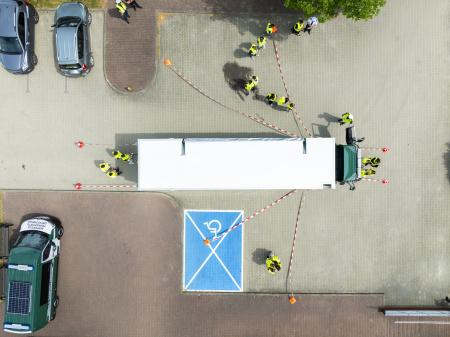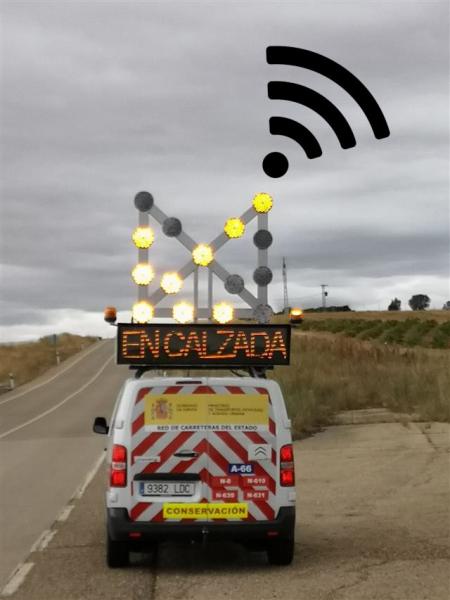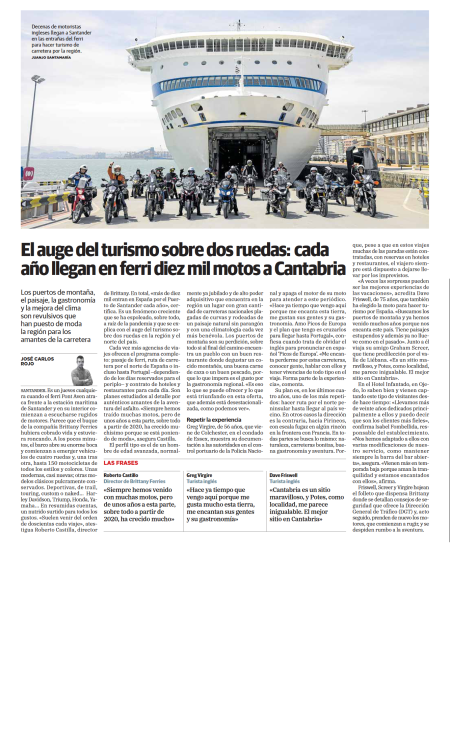Our members are dedicated to improving road safety and sharing their knowledge with the wider community. Here, you can explore our members' good practices – initiatives that have been assessed for their effectiveness in addressing a road safety problem and have proven results.
Get inspired – and sign up to share your good practices too!

Friday, June 7, 2024
More than 6000 children up to the age of 14 died between 2011 and 2020 in road collisions in the European Union. In 2023 there were 1,778 road crashes involving children in Poland
aged 0-14: 48 children died and 1,832 were injured. About 45.7% of all road crashes victims in Poland are vulnerable
road traffic users. Many of them involve children in rural areas.
aged 0-14: 48 children died and 1,832 were injured. About 45.7% of all road crashes victims in Poland are vulnerable
road traffic users. Many of them involve children in rural areas.

Thursday, June 6, 2024
According to the 2023 report from the Spanish General Directorate of Traffic (DGT), run off accidents are the accidents with the highest fatality rates (42% of the total). This figure has seen no improvement in the last five years, but has actually worsened slightly.
With the objective of finding solutions to this serious traffic, social and health problem, and aligned with the EU-supported ‘Vision Zero’ strategy, Metalesa has led pioneering scientific research in cooperation with the University of Valencia.
Using official accident data from police databases, up to 56,607 run off accidents with victims were analysed. One of the conclusions is the need to install approved vehicle restraint systems (passive road safety), while the other main conclusion is that installing them with embedded new Intelligent Transportation Systems (ITS) technologies may prevent up to 43.5% of all run off accidents (active road safety).
Armed with these results, Metalesa has developed a versatile and innovative technology system, PLUG&META®, that integrates into any road equipment and – through a network of sensors – is able to detect risk scenarios on the road, warn users in real time of hazardous situations and report the data to the competent authorities.
PLUG&META® allows any existing passive equipment to be transformed into smart and connected ones. This is what we call “Active Road Safety for infrastructure”. It is easy to install, affordable, and versatile enough to be incorporated into any road system equipment. It prevents run off accidents by identifying risks in real time and signalling them in order to alert road users. Some of the main risks that can be detected and warned about include:
- Crashes against the equipment
- Problematic time zone
- Limited or reduced visibility
- Risk of ice on the carriageway
- Strong gusts of winds
- Presence of cyclists, pedestrian or animals on the road
- Excessive speeds
- Nearby traffic jams
- Roadworks
- Tight or dangerous bends
- Coordination with traffic lights
All data and control of the different uses and configurations of the technology is via the PLUG&META® TRACE platform. This management platform allows municipal or road administrators to monitor the different smart infrastructures from anywhere thanks to its remote connection.
Through the platform, administrators can check the correct functioning of each device, the road safety alerts that have been registered, the signalling method for each risk scenario, the road safety statistics generated by the smart infrastructures, user and role management and alert validation, among other options. It is a responsive platform, which can be used remotely on any device with an internet connection.
It also allows integration with other third-party management platforms already used in the administrations.
The technological system described and proposed for the award is totally innovative worldwide for its ability to integrate (in a simple, effective and economical way) all these features in a single device at the same time, simply using a plug&play connection for the sensors, those that each administration needs in each scenario.
With this solution, any road administration, and society in general, would have a wide and varied network of equipment available that can ensure the safety of users autonomously and in real time, signalling only those situations that pose a potential risk.
Roads therefore become a safer, dynamic, interactive, protected environment, which will contribute to reducing the number of road accidents.
In summary, the innovative system described above is composed of two well-structured and coherent axes: scientific-technical research on run off traffic accidents + innovative and patented digital technology that provides the infrastructure with Active (preventive) Road Safety. This is an important step in the roadmap towards Smart Roads, facilitating modal coexistence between users, and contributing to reducing the likelihood of run off accidents, which, as previously mentioned, is one of the most serious problems for road safety, as it is the type of accident that causes the most victims each year in Spain and Europe.
With the objective of finding solutions to this serious traffic, social and health problem, and aligned with the EU-supported ‘Vision Zero’ strategy, Metalesa has led pioneering scientific research in cooperation with the University of Valencia.
Using official accident data from police databases, up to 56,607 run off accidents with victims were analysed. One of the conclusions is the need to install approved vehicle restraint systems (passive road safety), while the other main conclusion is that installing them with embedded new Intelligent Transportation Systems (ITS) technologies may prevent up to 43.5% of all run off accidents (active road safety).
Armed with these results, Metalesa has developed a versatile and innovative technology system, PLUG&META®, that integrates into any road equipment and – through a network of sensors – is able to detect risk scenarios on the road, warn users in real time of hazardous situations and report the data to the competent authorities.
PLUG&META® allows any existing passive equipment to be transformed into smart and connected ones. This is what we call “Active Road Safety for infrastructure”. It is easy to install, affordable, and versatile enough to be incorporated into any road system equipment. It prevents run off accidents by identifying risks in real time and signalling them in order to alert road users. Some of the main risks that can be detected and warned about include:
- Crashes against the equipment
- Problematic time zone
- Limited or reduced visibility
- Risk of ice on the carriageway
- Strong gusts of winds
- Presence of cyclists, pedestrian or animals on the road
- Excessive speeds
- Nearby traffic jams
- Roadworks
- Tight or dangerous bends
- Coordination with traffic lights
All data and control of the different uses and configurations of the technology is via the PLUG&META® TRACE platform. This management platform allows municipal or road administrators to monitor the different smart infrastructures from anywhere thanks to its remote connection.
Through the platform, administrators can check the correct functioning of each device, the road safety alerts that have been registered, the signalling method for each risk scenario, the road safety statistics generated by the smart infrastructures, user and role management and alert validation, among other options. It is a responsive platform, which can be used remotely on any device with an internet connection.
It also allows integration with other third-party management platforms already used in the administrations.
The technological system described and proposed for the award is totally innovative worldwide for its ability to integrate (in a simple, effective and economical way) all these features in a single device at the same time, simply using a plug&play connection for the sensors, those that each administration needs in each scenario.
With this solution, any road administration, and society in general, would have a wide and varied network of equipment available that can ensure the safety of users autonomously and in real time, signalling only those situations that pose a potential risk.
Roads therefore become a safer, dynamic, interactive, protected environment, which will contribute to reducing the number of road accidents.
In summary, the innovative system described above is composed of two well-structured and coherent axes: scientific-technical research on run off traffic accidents + innovative and patented digital technology that provides the infrastructure with Active (preventive) Road Safety. This is an important step in the roadmap towards Smart Roads, facilitating modal coexistence between users, and contributing to reducing the likelihood of run off accidents, which, as previously mentioned, is one of the most serious problems for road safety, as it is the type of accident that causes the most victims each year in Spain and Europe.

Thursday, June 6, 2024
Currently, infrastructure maintenance services equip vehicles with variable message panels with luminous arrows and chevrons. At Alvac, we are enhancing safety by connecting these systems with Waze, DGT 3.0, and the National Traffic Access Point.
This integration offers numerous benefits for road safety and traffic management. It would provide real-time information to drivers about the location of maintenance work through car navigation systems, allowing them to adjust routes and speeds to reduce accident risks.
Precise and timely alerts would increase the visibility of maintenance work and protect workers on the road, reducing the likelihood of accidents. Additionally, navigation applications could automatically plan alternative routes to avoid work zones, minimizing congestion and improving traffic flow.
Shared information would facilitate a quicker and more coordinated response from emergency services in case of accidents near work zones. Furthermore, data collected by Waze and DGT 3.0 could be analyzed to identify patterns and improve road safety and traffic management.
In summary, connecting the ASPA Flecha system with Waze, DGT 3.0, and the National Traffic Access Point would significantly enhance safety and efficiency on the roads.
This integration offers numerous benefits for road safety and traffic management. It would provide real-time information to drivers about the location of maintenance work through car navigation systems, allowing them to adjust routes and speeds to reduce accident risks.
Precise and timely alerts would increase the visibility of maintenance work and protect workers on the road, reducing the likelihood of accidents. Additionally, navigation applications could automatically plan alternative routes to avoid work zones, minimizing congestion and improving traffic flow.
Shared information would facilitate a quicker and more coordinated response from emergency services in case of accidents near work zones. Furthermore, data collected by Waze and DGT 3.0 could be analyzed to identify patterns and improve road safety and traffic management.
In summary, connecting the ASPA Flecha system with Waze, DGT 3.0, and the National Traffic Access Point would significantly enhance safety and efficiency on the roads.

Tuesday, June 4, 2024
The Autonomous Community of Cantabria and adjacent communities, such as Asturias and the Basque Country, offer spectacular mountain scenery and numerous roads through mountain passes, picturesque towns and villages. In addition, these regions are known for their delicious gastronomy.
This attractive scenery and the rich culinary offerings attract numerous motorcyclists every year, both national and foreign, who wish to travel the roads, climb the mountain passes and enjoy the local environment and gastronomy.
Motorbike tourism has been growing over the years, as has the evolution of the accident rate. From 2012 to 2023, an increase in the number of motorcyclists killed in road accidents in Spain has been detected, from 218 in 2012 to 286 in 2023. 77% of these drivers killed in road accidents were driving on conventional roads.
For this reason, the Directorate-General of Traffic (DGT) and Brittany Ferries have set up a collaboration project so that all motorcyclists disembarking in Cantabria have prior information on the current traffic regulations in Spain, with the aim of reducing the number of motorcyclists killed and making the roads safer for everyone.
This attractive scenery and the rich culinary offerings attract numerous motorcyclists every year, both national and foreign, who wish to travel the roads, climb the mountain passes and enjoy the local environment and gastronomy.
Motorbike tourism has been growing over the years, as has the evolution of the accident rate. From 2012 to 2023, an increase in the number of motorcyclists killed in road accidents in Spain has been detected, from 218 in 2012 to 286 in 2023. 77% of these drivers killed in road accidents were driving on conventional roads.
For this reason, the Directorate-General of Traffic (DGT) and Brittany Ferries have set up a collaboration project so that all motorcyclists disembarking in Cantabria have prior information on the current traffic regulations in Spain, with the aim of reducing the number of motorcyclists killed and making the roads safer for everyone.

Monday, June 3, 2024
Road deaths are the leading cause of death among young people aged 18 to 24 in France. Given this situation, the Prévention Routière association is convinced that participative prevention by young people for young people is likely to bring about a lasting change in attitudes to road risks.
In 2023, 502 people aged between 18 and 24 were killed on the roads, i.e. almost 10 every week. 52,749 young people were also injured on the road, i.e. more than a thousand are injured every week.
In the first quarter of 2024, the number of road deaths among people aged 18 to 24 years of age rose by 29% compared with the previous year.
In 2023, 502 people aged between 18 and 24 were killed on the roads, i.e. almost 10 every week. 52,749 young people were also injured on the road, i.e. more than a thousand are injured every week.
In the first quarter of 2024, the number of road deaths among people aged 18 to 24 years of age rose by 29% compared with the previous year.